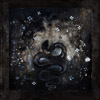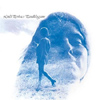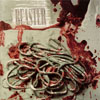23five
 This two-disc compilation coincides with last year's SFMOMA exhibit ofthe same name, a "listening event documenting the past 18 years ofJapanese experimental music," though this recording features mostlyelectronic-oriented material from the past few years. Despite this, itsbreadth is exceptional and some of the tracks are unreleased, so it'sexcellent both for collectors or as an introduction.
This two-disc compilation coincides with last year's SFMOMA exhibit ofthe same name, a "listening event documenting the past 18 years ofJapanese experimental music," though this recording features mostlyelectronic-oriented material from the past few years. Despite this, itsbreadth is exceptional and some of the tracks are unreleased, so it'sexcellent both for collectors or as an introduction.
Noise, of course, is a focal point, and each of the several noisepieces are quite distinct—Pain Jerk's track is a rumbling, rhythmicassault in contrast to Masonna's brighter vocal and synth-drivenfreakout. The Otomo Yoshihide track, consisting only of high frequencyguitar feedback, is easily the toughest; he exploits the subtleinteraction of two tonally pure sustained notes, holding them foruncomfortable lengths of time. It's interesting and challenging but Iprefer his more dynamic work.
Other tracks range from minimalist-inspired rhythmic clicks, such asthe Nerve Net Noise, Atau Tanaka, and Ryoji Ikeda tracks, which allmanage to distinguish themselves with their detailed but disarminglysimple tonal palettes, to more abstract, juxtaposed medleys. MasahiroMiwa's contribution uses plaintive low-fi synths to establish tension;though the sounds are light and playful, the overall feel is heavy andworks well with his stated topic of youth violence in Japan. I likeI.d.'s supposedly "hacker"-inspired piece. Its discrete bundles ofstatic and waves of digital noise sound almost like information, and itslowly develops into something vaguely repetitive and structured.
The compilation also features a few notable older but forward-lookingpieces. Yasunao Tone's track is about contrasts: beauty and ugliness aswell as ancient and modern, combining gorgeous flute playing and anoisy synth that sounds like the creaking of a door. The music stopsperiodically for an NPR-type voice to read some semi-decent poetry;although the track is long and generally simple, it's still engagingand I love the flute playing.
The Kazuo Uehara composition, dating back to 1988, has the mostimpressive sounds on the disc. It begins with some quiet, indeterminateevents and some mumbled French with a cavernous echo, and the vocalsgrow increasingly processed and alien. Stunning woodwind-like dronesbuild towards an organ-like range and later into hauntingly serenehowling and whistling. The ground that this compilation covers, as awhole, is amazing, and it definitely reaffirms the brilliance ofJapanese musical innovation.
samples:
 A new Comus EP has been on the cards for a few years as the group reinvigorated itself with a number of successful reunion shows. New songs crept into their set and finally a mini-album of fresh material has made it out into the wild. Not only that, the three studio recordings are bolstered with a bootleg recording of a 1972 performance of "The Malgaard Suite," their aborted second album (not to be confused with 1974’s To Keep from Crying). Overall, it does not reach the dizzying heights of First Utterance but it is a worthy return for such a legendary group.
A new Comus EP has been on the cards for a few years as the group reinvigorated itself with a number of successful reunion shows. New songs crept into their set and finally a mini-album of fresh material has made it out into the wild. Not only that, the three studio recordings are bolstered with a bootleg recording of a 1972 performance of "The Malgaard Suite," their aborted second album (not to be confused with 1974’s To Keep from Crying). Overall, it does not reach the dizzying heights of First Utterance but it is a worthy return for such a legendary group.


 For his installment in the Utech URSK series, Justin Broadrick's earliest project channels some of his older dark ambient work under that moniker, but also brings up some of his earliest days of harsh noise and power electronics as well, making for some of the rawest Final work that he’s released yet.
For his installment in the Utech URSK series, Justin Broadrick's earliest project channels some of his older dark ambient work under that moniker, but also brings up some of his earliest days of harsh noise and power electronics as well, making for some of the rawest Final work that he’s released yet. Since childhood Perhacs has composed music using elements from her visualization of sound (color frequencies, musical shapes, etc,...). This cult album from 1970 combines ethereal folk with flourishes of electronics and spacey jazz. Eight bonus tracks, fascinating notes, and sketches make this a worthwhile reissue.
Since childhood Perhacs has composed music using elements from her visualization of sound (color frequencies, musical shapes, etc,...). This cult album from 1970 combines ethereal folk with flourishes of electronics and spacey jazz. Eight bonus tracks, fascinating notes, and sketches make this a worthwhile reissue. Much to the chagrin of bloated record labels and those authoritarian grumps at the RIAA, young people today have near instantaneous and essentially free access to virtually any song thanks to the proliferation of torrents and other file sharing schemes. That brazen attitude inevitably had to expand to music composition, though, as this album proves, that might not be entirely for the best.
Much to the chagrin of bloated record labels and those authoritarian grumps at the RIAA, young people today have near instantaneous and essentially free access to virtually any song thanks to the proliferation of torrents and other file sharing schemes. That brazen attitude inevitably had to expand to music composition, though, as this album proves, that might not be entirely for the best. When this EP first came out it made little sense to me. The six songs were recorded during the same session as Copper Blue but the sound was completely different. The sound was rather grim, there were no happy singalongs, the vocals were buried (if present at all), and I didn't quite understand if it was attempting to be religious statement or not. Nineteen years later, a cleaned up master and back story makes a world of distance as it almost completely makes sense now.
When this EP first came out it made little sense to me. The six songs were recorded during the same session as Copper Blue but the sound was completely different. The sound was rather grim, there were no happy singalongs, the vocals were buried (if present at all), and I didn't quite understand if it was attempting to be religious statement or not. Nineteen years later, a cleaned up master and back story makes a world of distance as it almost completely makes sense now. This long unavailable album marks an important step in the development of Drew Daniel and MC Schmidt's music in that it is the first themed album of many in their career, which is one of the defining features that makes Matmos so interesting. Anyone can try and be clever with quirky samples but with The West, Matmos rose above using novelty sounds just for the sake of them. At this point they became an intellectually challenging but still musically compelling entity.
This long unavailable album marks an important step in the development of Drew Daniel and MC Schmidt's music in that it is the first themed album of many in their career, which is one of the defining features that makes Matmos so interesting. Anyone can try and be clever with quirky samples but with The West, Matmos rose above using novelty sounds just for the sake of them. At this point they became an intellectually challenging but still musically compelling entity. Many were devastated by the untimely loss of Jeff Buckley to a drowning accident in Memphis in May 1997. Not only had such an outstanding vocalist, musician and songwriter, who spoke to so many with his music, met a premature death, but he had made such an impact with only one studio album to his name.
Many were devastated by the untimely loss of Jeff Buckley to a drowning accident in Memphis in May 1997. Not only had such an outstanding vocalist, musician and songwriter, who spoke to so many with his music, met a premature death, but he had made such an impact with only one studio album to his name. This two-disc compilation coincides with last year's SFMOMA exhibit ofthe same name, a "listening event documenting the past 18 years ofJapanese experimental music," though this recording features mostlyelectronic-oriented material from the past few years. Despite this, itsbreadth is exceptional and some of the tracks are unreleased, so it'sexcellent both for collectors or as an introduction.
This two-disc compilation coincides with last year's SFMOMA exhibit ofthe same name, a "listening event documenting the past 18 years ofJapanese experimental music," though this recording features mostlyelectronic-oriented material from the past few years. Despite this, itsbreadth is exceptional and some of the tracks are unreleased, so it'sexcellent both for collectors or as an introduction. Pleasurehorse populates the songs on "Bareskinrug" with pummelingpolyrhythms which erupt arbitrarily all over the place. The sound isdense, heavy, and percussive. The pounding throughout "Bareskinrug" iscreated primarily by the bass beat, which provides the bed from whichthe other minor beats spring, sometimes blossoming, sometimeswithering. Amidst the percussion, you can pick out the synthesizedcomputer noises which fizzle, fizz and fiddle. Whereas I was astoundedby the violence of the sound, I also felt like I was being attacked bythe songs, which is just to say that at no point was "Bareskinrug"removed to the background of my mind. The music draws an adamant linein the mind's foreground, refusing to cross over into some lost ambientland. "Laitbait" felt like being cudgeled with a tomahawk repeatedlyand then the subsequent dizzied and blood-speckled daze whichaccompanies such a bludgeoning. The full range of this experience wascaptured within just the three minutes of this song. Most of the othersongs can be likened to some other violent or intense sensation. Theonly time at which the album threatened to be boring was "Re: Vip,"which maintains the same dull beat for three minutes, with nothinghovering around it to give it much life. When it finally promises tochange the beat, the song merely morphs into a duller beat perpetuatinguntil the end. The range of sound on the album as a whole is not thatwide, but the recombination of sounds is innovative. "Bareskinrug" isinteresting to listen to at first, but has a hard time sustainingmultiple exposures, unless, of course, you find a song on it whichchanges your life for a few weeks. Otherwise, the aural assaults becomeall too similar, like the daily beatings from a schoolyard bully. Isthe day you got your nose bloodied much different than the day you gotyour arm pinned behind your back? Nonetheless, Pleasurehorse does a lotwith a little, and heavy-handedly suggests he might have some promisingwork yet to perfect.
Pleasurehorse populates the songs on "Bareskinrug" with pummelingpolyrhythms which erupt arbitrarily all over the place. The sound isdense, heavy, and percussive. The pounding throughout "Bareskinrug" iscreated primarily by the bass beat, which provides the bed from whichthe other minor beats spring, sometimes blossoming, sometimeswithering. Amidst the percussion, you can pick out the synthesizedcomputer noises which fizzle, fizz and fiddle. Whereas I was astoundedby the violence of the sound, I also felt like I was being attacked bythe songs, which is just to say that at no point was "Bareskinrug"removed to the background of my mind. The music draws an adamant linein the mind's foreground, refusing to cross over into some lost ambientland. "Laitbait" felt like being cudgeled with a tomahawk repeatedlyand then the subsequent dizzied and blood-speckled daze whichaccompanies such a bludgeoning. The full range of this experience wascaptured within just the three minutes of this song. Most of the othersongs can be likened to some other violent or intense sensation. Theonly time at which the album threatened to be boring was "Re: Vip,"which maintains the same dull beat for three minutes, with nothinghovering around it to give it much life. When it finally promises tochange the beat, the song merely morphs into a duller beat perpetuatinguntil the end. The range of sound on the album as a whole is not thatwide, but the recombination of sounds is innovative. "Bareskinrug" isinteresting to listen to at first, but has a hard time sustainingmultiple exposures, unless, of course, you find a song on it whichchanges your life for a few weeks. Otherwise, the aural assaults becomeall too similar, like the daily beatings from a schoolyard bully. Isthe day you got your nose bloodied much different than the day you gotyour arm pinned behind your back? Nonetheless, Pleasurehorse does a lotwith a little, and heavy-handedly suggests he might have some promisingwork yet to perfect. All functional humans have the capacity to make noise, whether it'swith what genetics gave them or the tools they make. However, very fewhave the capabilities of making noisy things sound amazing to the humanear. Some bands never achieve this. Thankfully, at least Jackie-OMotherfucker does a good job of achieving it about half the time oneach their albums. In all of my recordings of this Portland,Oregon-based collective, they have remained consistent between thenumber of songs that sound completely derivative and uninspiring tosongs that really sound like an impressively orchestrated group ofmusicians whose sounds amount to more than just chin-scratching mayhem.For the latest disc, the band opens with a track that doesn't move faroff the Molasses-like northern white guy hillbilly blues singing tipand follows it up with a track that kept me re-referring to the packageto make sure it wasn't an elaborate cover of Jandek's "Carnival Queen"with tape mutilations. It's at this point, however, that the ensembleis basically getting in gear. They pause for a 17-second instruction onplaying on "the seven" and by halftime through the immense (andperpetually changing) fourth track, "777 (Tombstone Massive)," I'mhappily lost in a daze. It opens with relentless drum and percussionpoundings then halts, restarting with a crackle, wind instruments,chimes and a low string drone. A quick rise reintroduces the forcefulpercussion from the first few moments but thankfully that dies down forthe mesmerising interplay between strings, winds, and chimes. Just wheneverything boils up to a clumsy, disorganized borderline masturbatoryjam with nobody paying attention to each other, (the end of "Feast ofthe Mau Ma") quietness befalls the record and all is good again. Thealbum ends with two more 10-minute pieces: a blissful quietinstrumental and a 'manual' loop of guitar and drums with distortedvocals which leaves me with an unsettling feeling despite theviolinists struggles to play something pleasant. One of these days thisband is either going to make a record that will be my favorite of theyear or send a pipe bomb to my P.O. box. I don't know which to fearmore.
All functional humans have the capacity to make noise, whether it'swith what genetics gave them or the tools they make. However, very fewhave the capabilities of making noisy things sound amazing to the humanear. Some bands never achieve this. Thankfully, at least Jackie-OMotherfucker does a good job of achieving it about half the time oneach their albums. In all of my recordings of this Portland,Oregon-based collective, they have remained consistent between thenumber of songs that sound completely derivative and uninspiring tosongs that really sound like an impressively orchestrated group ofmusicians whose sounds amount to more than just chin-scratching mayhem.For the latest disc, the band opens with a track that doesn't move faroff the Molasses-like northern white guy hillbilly blues singing tipand follows it up with a track that kept me re-referring to the packageto make sure it wasn't an elaborate cover of Jandek's "Carnival Queen"with tape mutilations. It's at this point, however, that the ensembleis basically getting in gear. They pause for a 17-second instruction onplaying on "the seven" and by halftime through the immense (andperpetually changing) fourth track, "777 (Tombstone Massive)," I'mhappily lost in a daze. It opens with relentless drum and percussionpoundings then halts, restarting with a crackle, wind instruments,chimes and a low string drone. A quick rise reintroduces the forcefulpercussion from the first few moments but thankfully that dies down forthe mesmerising interplay between strings, winds, and chimes. Just wheneverything boils up to a clumsy, disorganized borderline masturbatoryjam with nobody paying attention to each other, (the end of "Feast ofthe Mau Ma") quietness befalls the record and all is good again. Thealbum ends with two more 10-minute pieces: a blissful quietinstrumental and a 'manual' loop of guitar and drums with distortedvocals which leaves me with an unsettling feeling despite theviolinists struggles to play something pleasant. One of these days thisband is either going to make a record that will be my favorite of theyear or send a pipe bomb to my P.O. box. I don't know which to fearmore.
